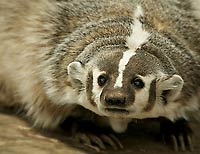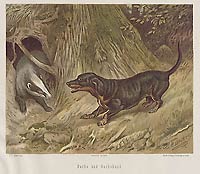The proverbial pooch has more than a “long” history behind its humorous hot dog credentials. Other than the obvious elongated body we wanted to know the real facts about this little frankfurter.

The question came about one afternoon when someone had made the comment that badgers, American badgers, are “bad asses”. There seems to be a common misperception, we thought. The American badger, identifiable by their distinctive lightning bolt shaped, head-markings and their huge fore claws are commonly compared to a wolverine, a member of the mustelidae family. Thus, the obvious comparison and ferocious, character assumption.
Our ever so popular culture, saturated with superheroes and internet fads has helped to create a fierce variation of the, “true” American badger when in-fact this furry, little walking footstool has been fought and hunted for centuries by Germany’s little sausage sniper, the dachshund.
In German, “Dachs” means badger and “Hund” means dog; thus, dachshund = badger dog. So who’s the “bad ass” now?! Does this mean the badger loses its superhero status or can we defend its predaceous demeanor? The badgers are definitely the biggest and toughest of the dachshunds quarry but it’s probably not saying much when you’re up against a “wiener” dog.

The wiener dog acknowledgments date back to the early 1540’s when royalty along with local foresters demanded destruction of dangerous pests, (such as the badger), so they could enjoy their land and more important forms of hunting with their prestigious guests. The dachshund’s characteristics make it difficult to tangle with and well adapted for fighting pests historically, such as the badger.
Drum roll please…. The name “wiener dog” was born in Frankfurt Germany in 1852 by a popular butcher in town. The butcher was not only well known for his delicious frankfurters but his lovable, little dachshund. The ever so obvious resemblance between the two led the butcher to name one of his popular frankfurter recipes, the Dachshund Sausage.
It wasn’t long before sausage vendors began selling dachshund sausages outside student dormitories and local events. The vendor carts eventually became coined as “Dog Carts”. The first recorded use of the term Hot Dog, according to Yale University was in 1895 although it hadn’t caught on until 1902 at a Giant’s baseball game.
Now, I know most of us have eaten a hot dog at a baseball game, after all, it is a favorite American pastime… eating that is. I know that one of the best parts of the purchase is flagging down the vendor who’s yelling “Get your red hot dog heeeere!” In 1902 the phrase commonly used was “get your dachshund sausage while it’s red hot”.
A cartoonist leaped at the opportunity to capture this iconic pastime and quickly threw together a sketch of a frankfurter with a tail and short, little stubby legs, not knowing what breed of dog or the history of the butcher’s buddy and captioned it “Hot Dog”!! The name stuck and from that day forward the wiener dog whether it be for eating and/or walking, has conquered our hearts, our super bowl commercials and our stomachs!
This article is brought to you by Animals of Montana specializing as a wildlife casting agency that has over 20 years of experience in this industry. They cater to the needs of photographers, amateur and professional and also to the motion film industry. For more information about tours please call 800-315-6948 or visit our website at www.AnimalsOfMontana.com